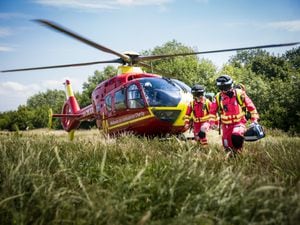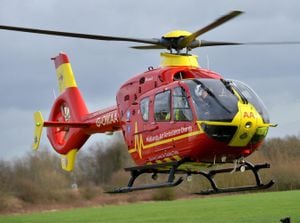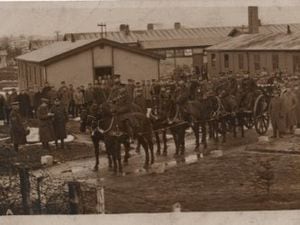West Midlands Air Ambulance: The lifesavers who stayed airborne through crisis
Midlands Air Ambulance was as busy as ever through lockdown, but the nature of emergencies it attended changed as society shut down.

The focus was on rank-and-file nurses as we entered lockdown.
Our National Health Service rightly became the nation’s pride, an institution powered by hard work and commitment that drove down the mortality rate and went above and beyond.
Another group were overlooked. The dedicated men and women who fly Air Ambulance missions in the skies above our region were seemingly forgotten.
As the focus turned to the large numbers of staff in hospitals and care homes, the smaller cohort flying equally important missions found themselves out of the spotlight.
It might reasonably have been assumed that they’d be less busy; after all, there were fewer people out and about, no competitive sport, a lack of vehicular traffic and hardly anybody in their normal place of work.
Logic might have suggested that there’d be far fewer – rather than far more – incidents for them to deal with. Logic, however, would have been wrong. For while the pandemic raged, the Midlands Air Ambulance found itself as busy as ever.
Helen Stevens, communications & marketing manager at Midlands Air Ambulance Charity, says: “From a clinical perspective, we made the assumption that the number of missions that we would called out to would be reduced.
"However, to our surprise, the number of missions we went to remained constant. There will still demand.”
What did change was the nature of incidents that the clinical team were called out to.
“Normally, we go to cardiac arrests and road traffic collisions on a regular basis, but following lockdown we instead found ourselves going to more incidents involving push bikes. People were obviously doing their exercise on bikes and accidents were arising.
“DIY was another area. People were doing stuff at home and having accidents, so we found ourselves going to more calls after DIY tasks had gone wrong.”
Ms Stevens added that a third major increase came from falls, some of which were combined with medical conditions and others that came about when people fell from ladders.
Falling
“Falls saw an increase. Some of them might have been because of a medical event, like a stroke, but others were from people falling from ladders while cleaning windows or working on trees.”
Those spikes allayed initial fears that the Midlands Air Ambulance would not be required to operate as frequently during the pandemic. In fact, it found itself operating at a level broadly similar to that recorded in non-Covid times.
“We were worried about whether the service would be required. But the team are called out as often as usual.”
There were other, more disturbing ways in which the service was required. The pandemic had a huge toll on people’s mental health as lockdown led to greater incidents of depression and isolation. People stuck indoors, finding themselves in dysfunctional relationships or suddenly being told they were being made redundant were overwhelmed by events.
That led to a surge in suicide attempts and incidents of serious self-harm. The Air Ambulance helped save countless lives.
Ms Stevens said: “There was a slight increase in incidents that reflected what was happening in society. People were feeling very isolated and alone during lockdown. Self-harming and suicide attempts increased and those were really distressing for the crew.”
They were not just distressing by nature of what had happened – but also because of the manner in which Air Ambulance personnel had to deal with them.
Due to Covid restrictions, staff had to wear heavy, uncomfortable breathing apparatus to avoid any infection from crew to patient or patient to crew.
“They were wearing level 3 breathing apparatus. They couldn’t communicate in quite the same way, or with the patients themselves. Having to shout through breathing apparatus made work very difficult.”
It is such details that are so often overlooked.
The Midlands Air Ambulance is a part of our daily lives. Each year it costs in excess of £10 million to maintain the three aircraft and the provision of a lifesaving service. Each air ambulance mission costs an average of £2,500. Each critical care car or cardiac car mission costs £224 on average. The charity does not receive funding from the Government or National Lottery for its daily missions so relies entirely on the support and generosity of local people and businesses.
Since 1991, it has responded to more than 62,000 missions, making it one of the busiest air ambulance services in the UK.

The service operates from strategically located regional airbases at RAF Cosford in Shropshire, Strensham in Worcestershire and Tatenhill in Staffordshire. Each aircraft carries a crew comprising a pilot, two paramedics or a paramedic and flight doctor, plus full life-support medical equipment. Three rapid response vehicles are deployed when the helicopters are unable to fly, due to bad weather for example.
In addition, the charity has two critical care cars – one covers Birmingham and the Black Country area, whilst the other attends missions in Worcestershire. Both are operational between 8am and 8pm daily. There is one critical care paramedic on-board each of the cars responding to medical incidents including heart attacks, strokes, sepsis and respiratory issues.
Every second counts in an emergency, to get the crew to scene to start treating patients, each minute costs £20 by critical care car and £156 by air ambulance.
The charity responds to some of the most traumatic incidents in the region, including cardiac arrests, road traffic collisions and sports injuries.
The aircraft is able to reach remote locations swiftly to attend to patients unreachable by land ambulance.
The service has changed dramatically since its inception.
Ms Stevens said: “The old analogy was that we’d scoop and go; literally picking people up and getting them to hospital as quickly as possible. Then we moved to the idea of the ‘golden hour’, when it was all about getting a patient to the appropriate hospital in that golden hour to improve their chances of recovery.
"Since then, the service has evolved further. Now we are spending more time providing hospital-level skills on the scene because the skills have improved. That’s having a marked effect on our survival statistics.”
The advent of Covid-19 didn’t only lead to a change in the type of incidents that the service attended, it also led to a change in operations. As infections raged, the service had to find ways of making sure its aircraft and cars were sterile so that it did not become responsible for transmitting infection to otherwise healthy individuals.
“We had to think not only about the people on board but also about the aircraft. It wasn’t just about keeping the team safe but also about keeping the patients safe.
We had to look at the helicopters and make sure there were screens in place for the helicopter pilots, who are not part of the medical crew. The PPE we needed was supplied to us by the ambulance service, which supported us. We had the best standard that the crew needed.”
Inevitably, some crew members became infected and had to spend time on the ground, in order to avoid infecting colleagues or patients who were being transferred to hospitals.
“We had periods of absence due to isolation. That had a knock-on effect on the roster. If somebody was taken out with high temperatures, it meant we had fewer people there to staff the missions.
“The crews were also very stringent they were stringent in what they were doing in their personal time to make sure they didn’t expose themselves to infection.”
Operational
Of course, the operational side of the Midlands Air Ambulance is only half the story. The other half is the way in which it is funded.
The service has a very clear mission: To provide patients with outstanding pre-hospital care and life saving intervention through the operation of helicopter-led emergency medical services.
It continues to save more lives and improve survivors’ quality of life through the provision of a comprehensive, transparent, clinical and operational helicopter led emergency service aligned to changing patient need and demand. That mission can only be achieved if it generates £10 million per year.
Ms Stevens said: “The significant impact was with the charity fundraising.
“As soon as lockdown hit we had to think about temporarily closing our charity shops. We had to postpone and then cancel our entire calendar of fund-raising events for the year.
"People in the community had to cancel their events too. We attend and support up to 300 per year from people who support us in the community and there are around 20 events of our own. They all went.
“We were significantly hit – we don’t have figures yet – but people supported us in so many other ways.
“Online fundraising changed the way we work. Also, we had people taking part in virtual challenges. We’ve developed new events that have raised tens of thousands of pounds.”
Once shops were re-opened, people returned in droves; eager to bag a bargain and offer financial support.
“People were coming back into the shop very quickly. Our Wellington shop, in Telford, saw a whole week’s takings in three days. That funds critical care missions.
“Our bottom line is that we have to raise £10 million per year and it looks likely that we’ve raised that irrespective of lockdown. We’re so humbled that the support is still there.”
Given the organisation’s charity status, is does not qualify for support from some of the work that fundraisers have conducted during the past year.
So, for instance, the vast treasure of money generated by the late Captain Sir Tom Moore remains out of bounds.
“We don’t get the NHS charity funding,” said Ms Stevens. “It’s purely down to the communities.”

That funding supports 2,000 missions per year across a huge geographical area that takes parts of rural Shropshire, Staffordshire and Worcestershire as well as the urban sprawl of the Black County and Birmingham.
It is clear that those will be maintained thanks to the innovation of fundraising staff and the support of local communities.
As lockdown slowly starts to ease, the organisation is seeing a return to the types of missions it flew before the pandemic.
“When we went into the first lockdown, there was a big drop in the number of road accidents because there were far fewer vehicles on our roads,” said Ms Stevens.
“However, during the first lockdown, people seemed to be driving faster because the roads were clear. So when we were called out to collisions, they were frequently worse and people were suffering more severe injuries because speed was increasingly a factor.
“As we emerge from lockdown, our work is starting to revert back to the sort of pattern we experienced previously.
"So we’re seeing more road traffic collisions that involve car versus car, rather than car versus pedal cycle.
“We’re going out to a lot more cardiac arrest. There has been a rise in equestrian incidents and accidents in other sports as people start to get out and about a bit more.
“Another cause for concern is stabbings, which have risen during the past five years.
"You could be forgiven for thinking those happen at night in inner cities – but clearly that cannot be the case because we don’t fly after 8pm. In fact, we are seeing those in daytime and in rural areas as well as our town centres.”
The pandemic created a once-in-a-lifetime challenge for the Midlands Air Ambulance. Thankfully, it’s a challenge that the service has been able to meet.
For more information or to make a donation, visit midlandsairambulance.com





